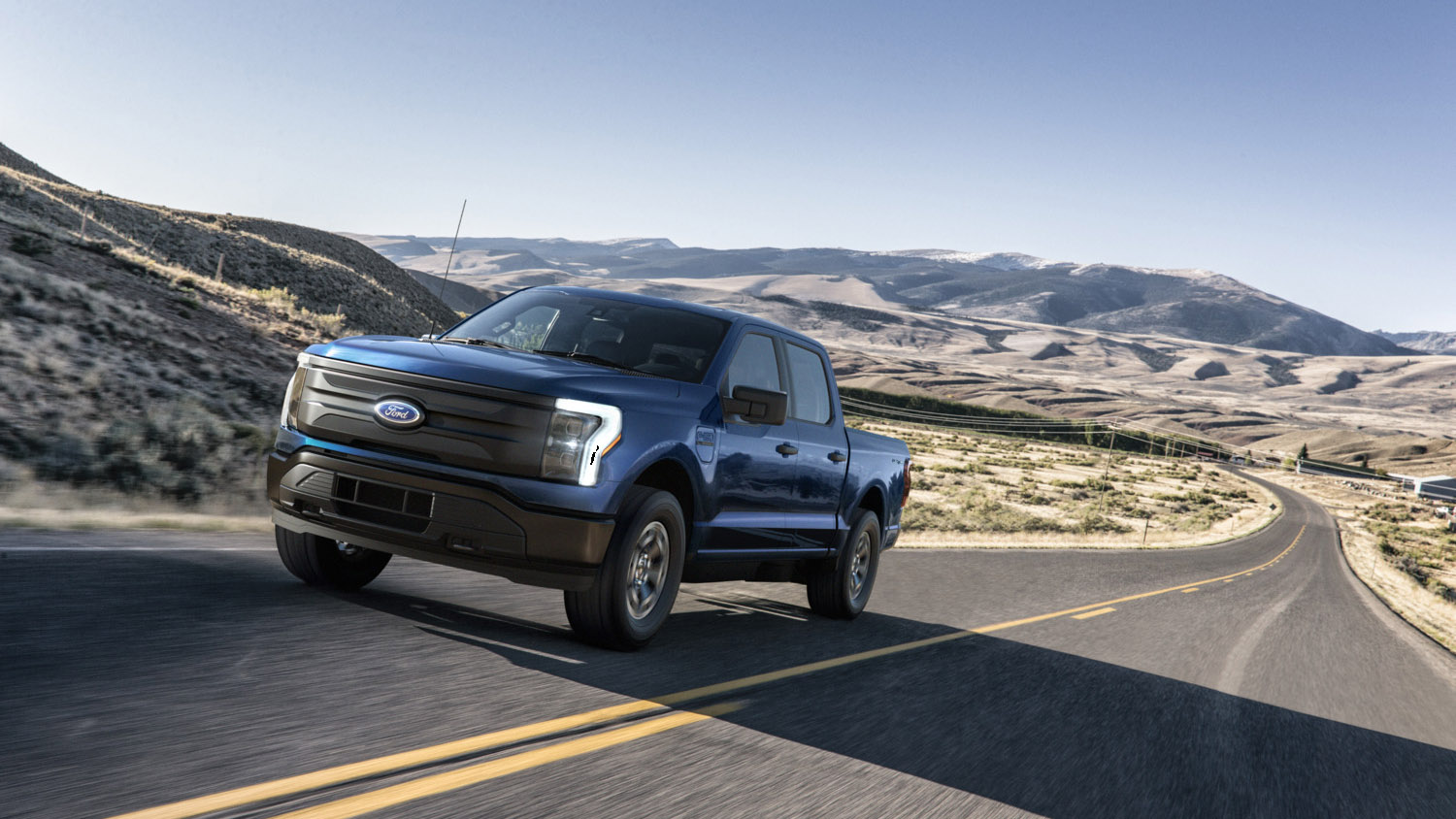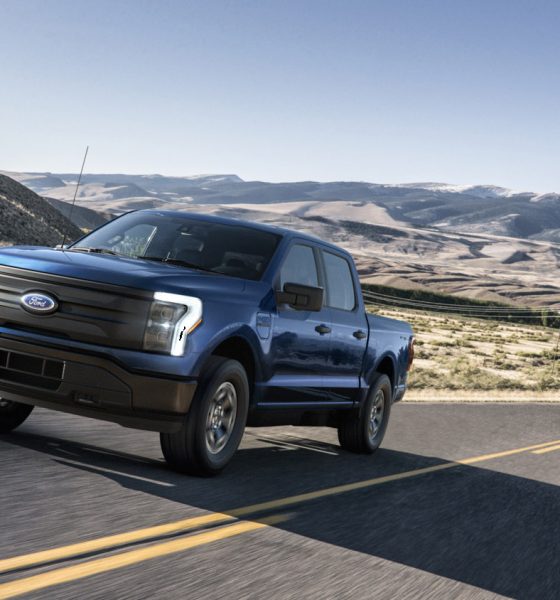

Investor's Corner
Tesla’s EV Seniority and how it could affect Ford’s price parity battle: Goldman Sachs
Tesla’s (NASDAQ: TSLA) seniority in the electric vehicle sector is proving to provide plenty of difficulty for the long-standing legends of the automotive industry. Ford’s (NYSE: F) recent unveiling of the all-electric version of the best-selling pickup truck in America with the F-150 Lightning was a step in the right direction for the Michigan-based car company. Still, its battle with price parity puts it in an awkward position, as other brands, especially Tesla, can offer a considerably more advanced product in terms of EV tech and range while offering a more affordable option through price per kilowatt-hour. Goldman Sachs released a note to investors that detailed Ford’s strong F-15o Lightning unveiling was the company “moving in the right direction,” but they’re still going to fighting an uphill battle for years to come.
Highlighting Ford’s ambitious plan to roll out 40% of its global production as electrified models by 2030, Goldman Sachs sees the automaker’s recent $8 billion increase in planned expenditures as a good thing. “The company’s EV lineup features what we view as attractive products, such as the Mustang Mach-E, E-Transit commercial van, and F-150 Lightning. More specifically on pickups, Ford expects one-third of all full-size pickup sales to be electric by 2030, and we expect the F-150 Lightning to be among the industry leaders given its features and price point.”
Goldman Sachs on Ford’s Q1 earnings ??
“While we believe that Ford is moving in the right direction (targeting under $100 per kWh by mid decade), Tesla is already at/near $100 at the pack level, and could be in the $60 range for some models by mid decade.”$F$TSLA pic.twitter.com/m6LVUBtxR9— David Tayar (@davidtayar5) May 28, 2021
The F-150 Lightning will offer competitive range, pricing, and performance options to compete with the Tesla Cybertruck and Rivian R1T. While it is still up in the air on what each automaker will deliver when their vehicles make it to customers, Ford offers a robust and strong F-150 comparative that brings some interesting competition to the table in terms of specs. However, Goldman Sachs is more concerned about Ford’s plan to tackle price parity, the relationship between the price of electric cars and gas cars.
“One of the key debates we expect among investors will be on EV profitability on a like-for-like basis with ICE. While we believe that Ford is moving in the right direction with a modular EV architecture and that its target to be under $100 per kWh by mid-decade will be competitive for the industry, we expect some peers to be ahead of this,” Goldman’s note says. “Tesla, we believe, is already at/near $100 at the pack level and could be in the $60 range for some models by mid-decade if it executes on its plan from its 2020 Battery Day.”
Tesla (TSLA) shares snatched up by ARK after Battery Day: “It’s going to be hard to catch up”
Tesla’s long-term chipping away at EV technology and battery developments is a key indicator of what is to come for the legacy automakers who are just getting into the sector of electrification. While Ford has a lineup of great products and EV releases that are expected to begin production in the coming years, Tesla’s seniority in the sector will always be a thorn in the side of traditional companies until, and if, they can catch up. Ultimately, until these companies can match Tesla’s pricing points, other companies will be offering inferior products at a higher price, boding well for Tesla’s domination of the ever-growing EV sector.
Disclosure: Joey Klender is a TSLA Shareholder.

Investor's Corner
Tesla stock closes at all-time high on heels of Robotaxi progress

Tesla stock (NASDAQ: TSLA) closed at an all-time high on Tuesday, jumping over 3 percent during the day and finishing at $489.88.
The price beats the previous record close, which was $479.86.
Shares have had a crazy year, dipping more than 40 percent from the start of the year. The stock then started to recover once again around late April, when its price started to climb back up from the low $200 level.
This week, Tesla started to climb toward its highest levels ever, as it was revealed on Sunday that the company was testing driverless Robotaxis in Austin. The spike in value pushed the company’s valuation to $1.63 trillion.
Tesla Robotaxi goes driverless as Musk confirms Safety Monitor removal testing
It is the seventh-most valuable company on the market currently, trailing Nvidia, Apple, Alphabet (Google), Microsoft, Amazon, and Meta.
Shares closed up $14.57 today, up over 3 percent.
The stock has gone through a lot this year, as previously mentioned. Shares tumbled in Q1 due to CEO Elon Musk’s involvement with the Department of Government Efficiency (DOGE), which pulled his attention away from his companies and left a major overhang on their valuations.
However, things started to rebound halfway through the year, and as the government started to phase out the $7,500 tax credit, demand spiked as consumers tried to take advantage of it.
Q3 deliveries were the highest in company history, and Tesla responded to the loss of the tax credit with the launch of the Model 3 and Model Y Standard.
Additionally, analysts have announced high expectations this week for the company on Wall Street as Robotaxi continues to be the focus. With autonomy within Tesla’s sights, things are moving in the direction of Robotaxi being a major catalyst for growth on the Street in the coming year.
Elon Musk
Tesla needs to come through on this one Robotaxi metric, analyst says
“We think the key focus from here will be how fast Tesla can scale driverless operations (including if Tesla’s approach to software/hardware allows it to scale significantly faster than competitors, as the company has argued), and on profitability.”

Tesla needs to come through on this one Robotaxi metric, Mark Delaney of Goldman Sachs says.
Tesla is in the process of rolling out its Robotaxi platform to areas outside of Austin and the California Bay Area. It has plans to launch in five additional cities, including Houston, Dallas, Miami, Las Vegas, and Phoenix.
However, the company’s expansion is not what the focus needs to be, according to Delaney. It’s the speed of deployment.
The analyst said:
“We think the key focus from here will be how fast Tesla can scale driverless operations (including if Tesla’s approach to software/hardware allows it to scale significantly faster than competitors, as the company has argued), and on profitability.”
Profitability will come as the Robotaxi fleet expands. Making that money will be dependent on when Tesla can initiate rides in more areas, giving more customers access to the program.
There are some additional things that the company needs to make happen ahead of the major Robotaxi expansion, one of those things is launching driverless rides in Austin, the first city in which it launched the program.
This week, Tesla started testing driverless Robotaxi rides in Austin, as two different Model Y units were spotted with no occupants, a huge step in the company’s plans for the ride-sharing platform.
Tesla Robotaxi goes driverless as Musk confirms Safety Monitor removal testing
CEO Elon Musk has been hoping to remove Safety Monitors from Robotaxis in Austin for several months, first mentioning the plan to have them out by the end of 2025 in September. He confirmed on Sunday that Tesla had officially removed vehicle occupants and started testing truly unsupervised rides.
Although Safety Monitors in Austin have been sitting in the passenger’s seat, they have still had the ability to override things in case of an emergency. After all, the ultimate goal was safety and avoiding any accidents or injuries.
Goldman Sachs reiterated its ‘Neutral’ rating and its $400 price target. Delaney said, “Tesla is making progress with its autonomous technology,” and recent developments make it evident that this is true.
Investor's Corner
Tesla gets bold Robotaxi prediction from Wall Street firm
Last week, Andrew Percoco took over Tesla analysis for Morgan Stanley from Adam Jonas, who covered the stock for years. Percoco seems to be less optimistic and bullish on Tesla shares, while still being fair and balanced in his analysis.

Tesla (NASDAQ: TSLA) received a bold Robotaxi prediction from Morgan Stanley, which anticipates a dramatic increase in the size of the company’s autonomous ride-hailing suite in the coming years.
Last week, Andrew Percoco took over Tesla analysis for Morgan Stanley from Adam Jonas, who covered the stock for years. Percoco seems to be less optimistic and bullish on Tesla shares, while still being fair and balanced in his analysis.
Percoco dug into the Robotaxi fleet and its expansion in the coming years in his latest note, released on Tuesday. The firm expects Tesla to increase the Robotaxi fleet size to 1,000 vehicles in 2026. However, that’s small-scale compared to what they expect from Tesla in a decade.
Tesla expands Robotaxi app access once again, this time on a global scale
By 2035, Morgan Stanley believes there will be one million Robotaxis on the road across multiple cities, a major jump and a considerable fleet size. We assume this means the fleet of vehicles Tesla will operate internally, and not including passenger-owned vehicles that could be added through software updates.
He also listed three specific catalysts that investors should pay attention to, as these will represent the company being on track to achieve its Robotaxi dreams:
- Opening Robotaxi to the public without a Safety Monitor. Timing is unclear, but it appears that Tesla is getting closer by the day.
- Improvement in safety metrics without the Safety Monitor. Tesla’s ability to improve its safety metrics as it scales miles driven without the Safety Monitor is imperative as it looks to scale in new states and cities in 2026.
- Cybercab start of production, targeted for April 2026. Tesla’s Cybercab is a purpose-built vehicle (no steering wheel or pedals, only two seats) that is expected to be produced through its state-of-the-art unboxed manufacturing process, offering further cost reductions and thus accelerating adoption over time.
Robotaxi stands to be one of Tesla’s most significant revenue contributors, especially as the company plans to continue expanding its ride-hailing service across the world in the coming years.
Its current deployment strategy is controlled and conservative to avoid any drastic and potentially program-ruining incidents.
So far, the program, which is active in Austin and the California Bay Area, has been widely successful.








